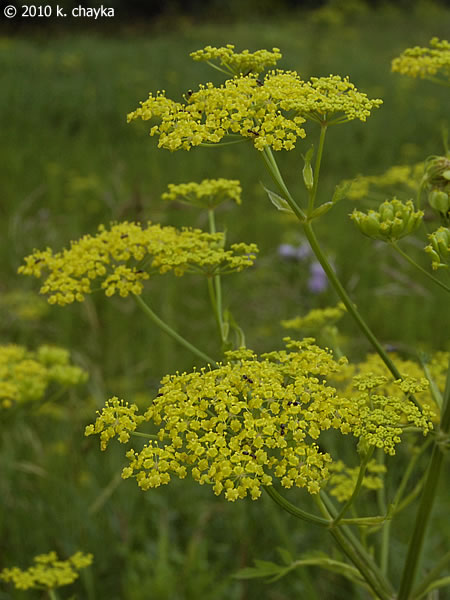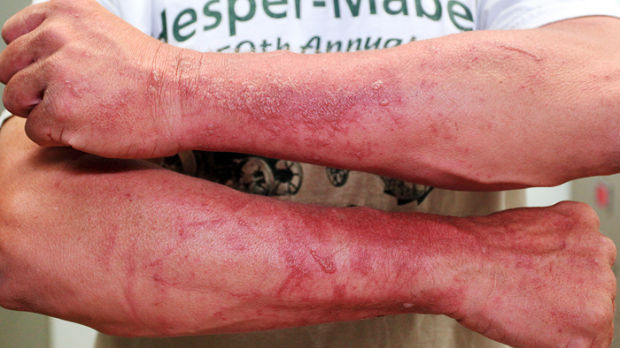Wild parsnip is back in southeast Minnesota and that’s not a good thing for man nor beast. According to the website www.invasivespecies.com, wild parsnip is also known as poisonous parsnip. When the sap from wild parsnip comes in contact with human skin that’s exposed to direct sunlight, the chemicals cause intense burns, rashes, or blisters. Take it from someone who knows.

James Colbenson, who once lived in the Chisholm Valley area between Rushford and Houston, had a run-in with wild parsnip back in his mid-teens. “I was looking to make money back then and the neighbors hired me to whack some of their weeds,” the now-34-year-old recalled. “I was wearing a cutoff shirt while I was working that day, so I got some of the sap on my arms, which were then sunburned too.
“I first remember it starting to sting,” he recalled. “When I got done working, I remember jumping in the pool and it burned everywhere. I had one small blister the next day, but over the next two days, my arms and my neck were just covered with inch-high blisters.”
Houston and Fillmore County Extension Agent Michael Cruse says the chemicals in the plants are in the seeds and especially in the stem. Once the chemicals get on to human skin and that person gets out into the sunlight, that’s when things begin to deteriorate.
“That’s when you start to see those blisters and burns,” Cruse said. “You really want to be vigilant and keep kids away from this stuff. If you are going out to clear this stuff off your property by hand, make sure you wear gloves, long sleeves, hats, and pants. Make sure you take care of those clothes because they’re going to have the chemical all over them.”

Southeast Minnesota sees the largest amount of wild parsnip in the state; however, the noxious weed is found in every county in Minnesota. Cruse says wild parsnip was a big topic of conversation a couple of years ago, and it’s a conversation-starter in county-level extension offices again. “Probably two years ago, we had the big flush of wild parsnip that led to a bunch of conversations at the county level,” he recalled.
“Last year, the populations seemed to drop off a bit,” Cruse said, “and I think a lot of that had to do with some aggressive spraying in the fall. The state roads saw a lot of mowing too. This is a good bounce-back year for the biennial weed because of the recent run of hot weather.”
Colbenson said it took a while before his family figured out that it was wild parsnip that caused the blisters on his arm and neck. “I felt a stinging/burning sensation when the sunburn really started to kick in,” he recalled. “The stinging and burning lessened as more and more blisters showed up. The blisters didn’t hurt as much but they were big and puffy.
“We tried a bunch of different ointments and anti-itch creams,” he said. “I know we also put a lot of Neosporin on them. I remember the blisters lasting about a week-and-a-half. They slowly went away after that, but they did leave some small scars on my arms.”
Colbenson lives in Rochester these days and travels back home to the Rushford area periodically. He says the weed has “taken over everywhere.” Colbenson says you can see the weed’s explosive growth in virtually every ditch near the road, as well as near rivers and streams.
It’s not just humans that need to worry about wild parsnip. Cruse says it’s important for livestock farmers to make sure their animals don’t ingest it either.
“If animals ingest the plant, the material will enter their bloodstream,” he said. “When it gets into the capillaries that run along the outer edge of the skin, the chemicals can react to the sunlight and cause some injuries there as well.”
Cruse said the burn can be extremely severe for both humans and livestock, depending on the level of contact with the skin and sunlight interaction. If it gets bad enough, this will be a “go to the doctor” type of event. What does wild parsnip look like?
“The first thing people will notice while they’re out driving is the yellow flower,” Cruse said. “But remember, not every yellow flower will be wild parsnip, either. The yellow flower on wild parsnip actually expands out and has a shape like an umbrella. The plant itself is typically four-to-five feet tall.
“It’s a biennial plant,” he added, “so it has a rosette. If you were to walk one of our local ditches in the fall, you’ll notice that virtually everything will be dead. However, there will be some green rosettes in the ditch too. There’s a better than decent chance at least some of that is going to be wild parsnip. It stays green later in the year, which is why that’s a good time to target it with some spraying.”
